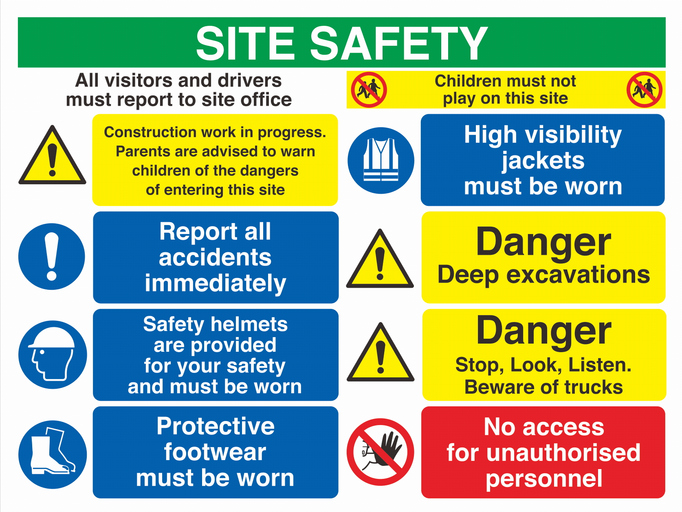Safety Colours
Red is a Safety Colour and must be used for any:
- prohibition sign concerning dangerous behaviour (eg. the safety colour on a 'No Smoking' sign). Prohibition signs must be round, with a black pictogram on a white background with red edging and a red diagonal line (top left, bottom right). The red part must take up at least 35% of the area of the sign;
- danger alarm concerning stop, shutdown, emergency cut out devices, evacuate (eg. the safety colour of an emergency stop button on equipment);
- fire-fighting equipment.
Red and white alternating stripes may be used for marking surface areas to show obstacles or dangerous locations.
Yellow (or amber) is a safety colour and must be used for any warning sign concerning the need to be careful, take precautions, examine or the like (eg. the safety colour on hazard signs, such as for flammable material, electrical danger, etc). Warning signs must be triangular, with a black pictogram on a yellow (or amber) background with black edging. The yellow (or amber) part must take up at least 50% of the area of the sign.
Yellow and black alternating stripes may be used for marking surface areas to show obstacles or dangerous locations.
Yellow may be used in continuous lines showing traffic routes.
Blue is a safety colour and must be used for any mandatory sign requiring specific behaviour or action (eg. the safety colour on a 'Safety Helmet Must Be Worn' sign or a 'Pedestrians Must Use This Route' sign). Mandatory signs must be round, with a white pictogram on a blue background. The blue part must take up at least 50% of the area of the sign.
Green is a safety colour and must be used for:
- emergency escape signs (eg. showing emergency doors, exits and routes) and first aid signs (eg. showing location of first aid equipment and facilities). Escape and first aid signs must be rectangular or square, with a white pictogram on a green background. The green part must take up at least 50% of the area of the sign. So long as the green takes up at least 50% of the area, it is sometimes permitted to use a green pictogram on a white background, for example where there is a green wall and the reversal provides a more effective sign than one with a green background and white border;
- no danger (eg. for 'return to normal').
White is NOT a safety colour but is used:
- for pictograms or other symbols on blue and green signs;
- in alternating red and white stripes to show obstacles or dangerous locations;
- in continuous lines showing traffic routes.
Black is NOT a safety colour but is used:
- for pictograms or other symbols on yellow (or amber) signs and, except for fire signs, red signs;
- in alternating yellow and black stripes to show obstacles or dangerous locations.


